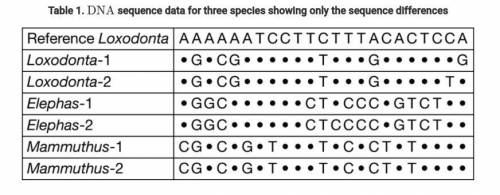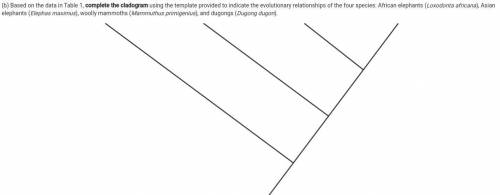
Biology, 12.05.2021 04:00 pishoy9357
HELP
Read each question carefully. Write your response in the space provided for each part of each question. Answers must be written out in paragraph form. Outlines, bulleted lists, or diagrams alone are not acceptable and will not be scored.
Researchers studying the phylogenetic relationships among African elephants (Loxodonta africana), Asian elephants (Elephas maximus), and woolly mammoths (Mammuthus primigenius) analyzed cytochrome b DNA sequences from several organisms of each species. Cytochrome b is a mitochondrial protein that functions in the electron transport chain. Partial sequences of cytochrome b mitochondrial DNA are often used in phylogenetic analyses. DNA was obtained from mammoth bone fragments radiocarbon dated to between 12,000 and 14,000 years ago and from living African and Asian elephants. Table 1 shows a partial cytochrome b DNA sequence for the reference individual (an African elephant) and some of the sample individuals studied. Dugongs (Dugong dugon) were identified as the outgroup in this study. Dugongs are marine mammals that are relatives of the larger group of elephant-like animals, the proboscideans.
(a) Based on the data in Table 1, identify the animal that has the greatest number of sequence differences from the reference animal.
(b) Based on the data in Table 1, complete the cladogram using the template provided to indicate the evolutionary relationships of the four species: African elephants (Loxodonta africana), Asian elephants (Elephas maximus), woolly mammoths (Mammuthus primigenius), and dugongs (Dugong dugon).
(c) Based on morphological and molecular data, researchers hypothesize that the split between dugongs and proboscideans likely occurred between 48 and 34 million years ago. Explain how molecular data from fossils and living organisms would support the existence of an evolutionary relationship between dugongs and proboscideans.
(d) There are six living species of mammals called hyraxes in the order Hyracoidea. These are small rabbit-like mammals that are also considered to be close relatives of both dugongs and elephants. All of these mammals are widely different morphologically. Explain how organisms that are widely different in morphology can have a close evolutionary relationship.



Answers: 2


Another question on Biology

Biology, 21.06.2019 22:30
How can you approximate the number of calories required to keep you in energy balance?
Answers: 2

Biology, 22.06.2019 08:30
Which best describes a benefit of using dna technology in medicine? a) medicine can be produced in mass quantities. b) medicine can be distributed at a reduced cost. c) medicines have fewer side effects. d) medicines are resistant to antibiotics.
Answers: 3

Biology, 22.06.2019 11:30
What materials must dams have to produce electricity, and what must occur?
Answers: 1

You know the right answer?
HELP
Read each question carefully. Write your response in the space provided for each part of each...
Questions




Business, 17.04.2021 23:40





Advanced Placement (AP), 17.04.2021 23:40




Mathematics, 17.04.2021 23:40


Mathematics, 17.04.2021 23:40

Arts, 17.04.2021 23:40

Mathematics, 17.04.2021 23:40

Mathematics, 17.04.2021 23:40

English, 17.04.2021 23:40



